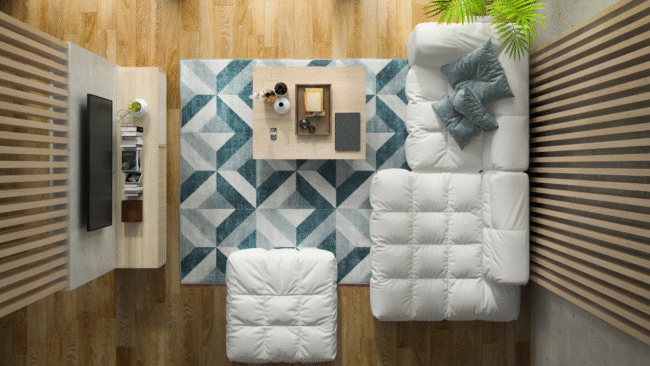
Living in a compact space doesn’t mean you have to sacrifice style or comfort. Small living rooms present unique challenges, but with the right approach, you can create a space that feels open, inviting, and perfectly functional.
Whether you’re furnishing a cozy apartment or trying to make the most of a modest family room, these layout tricks will help you transform your compact living space into something that feels surprisingly spacious and utterly stylish.
Understanding Your Small Living Room’s Potential
Before diving into specific layout strategies, it’s essential to evaluate what you’re working with. Taking time to understand your room’s dimensions, architectural features, and traffic patterns will guide all your design decisions moving forward.
Assessing Your Space Dimensions
Start by measuring your room accurately, including ceiling height. Note the position of windows, doors, electrical outlets, and any architectural quirks like alcoves or angled walls. These measurements will become your roadmap for furniture selection and placement.
Identifying Traffic Patterns
Pay attention to how people naturally move through the room. You’ll want to maintain clear pathways of at least 30 inches between furniture pieces to avoid a cramped feeling. Mapping traffic flow helps you position furniture in a way that enhances functionality rather than obstructing movement.
The Psychology of Space Perception
Our perception of space is influenced by more than just physical dimensions. Factors like lighting, color, and visual weight of objects all affect how spacious a room feels. Understanding these principles lets you make choices that visually expand your space, even when square footage is limited.
Now that you have a better understanding of your space, let’s explore specific strategies to maximize it through thoughtful furniture choices and arrangements.
1. Strategic Furniture Placement with Modular Solutions
Small spaces demand furniture that works harder and adapts to your needs. Modular furniture offers unparalleled flexibility, allowing you to reconfigure your space as needed.
Embracing Modular Sectional Sofas
A modular sectional sofa can be the perfect solution for a small living room. Unlike traditional sofas, these versatile pieces can be arranged in multiple configurations to fit your space perfectly. Many living room sectional sets feature movable components that can be rearranged for different activities or when entertaining guests.
Storage-Integrated Seating
Look for a modular sofa with storage to maximize functionality in limited space. These clever pieces offer hidden compartments beneath cushions or in ottoman components, perfect for stashing throws, magazines, or remote controls. A modular sofa with storage eliminates the need for additional storage furniture, freeing up valuable floor space.
Creating Conversation Areas
Arrange your modular sectional sofa to create intimate conversation areas. This approach works particularly well in open-concept spaces where defining separate functional zones can be challenging.
The right arrangement creates a cozy, inviting atmosphere without making the room feel cluttered. The versatility of modular furniture provides a solid foundation for your small living room. Now let’s explore how breaking conventional furniture placement rules can further enhance your space.
2. Float Your Furniture for Enhanced Spatial Flow
Traditional interior design often pushes furniture against walls, but this approach can make small rooms feel boxed in and static. Consider a more dynamic arrangement to breathe life into your space.
Breaking the Wall-Hugging Habit
Try pulling some furniture pieces away from the walls to create a more interesting layout. Even moving a sofa just a few inches from the wall can make the room feel less rigid. This technique works particularly well in small living room layout ideas that need to avoid a cramped feeling.
Defining Conversation Areas
Use area rugs to anchor floating furniture arrangements and create defined zones within your space. This strategy is especially effective in open-concept homes where visual boundaries help organize different functional areas without physical walls.
Maintaining Proper Clearance
While floating furniture creates a more dynamic feel, be sure to leave adequate space for movement. Maintain at least 18 inches between a coffee table and seating, and ensure there’s a clear path of at least 30 inches for walking through the room.
Floating your furniture creates a more sophisticated arrangement with better flow. Next, let’s look upward to maximize another often-overlooked dimension in small spaces.
3. Vertical Space Maximization Techniques
When floor space is at a premium, your walls become invaluable real estate. Making the most of vertical space draws the eye upward, creating the illusion of a larger room.
Floor-to-Ceiling Storage Solutions
Install shelving that extends from the floor to the ceiling to maximize storage while creating visual interest. Tall bookcases or custom-built-ins not only provide practical storage but also draw the eye upward, making ceilings appear higher.
Wall-Mounted Options
Wall-mounted TV units, desks, and even lighting fixtures free up floor space while maintaining functionality. These floating elements create an airier feel compared to their floor-standing counterparts, which is essential in implementing effective small living room layout ideas.
Strategic Upper Wall Decoration
Decorate the upper portion of your walls with art or mirrors to encourage upward gazes. This simple trick expands the perceived space by activating areas that might otherwise be ignored.
With vertical space optimized, it’s time to focus on furniture that can serve multiple purposes in your limited square footage.
4. Multi-Functional Furniture Integration
In small spaces, each piece of furniture should earn its keep by serving more than one function. This approach maximizes utility while minimizing the footprint of your furnishings.
Transforming Furniture Solutions
Consider pieces that can change form based on your needs: nesting tables that can be spread out when entertaining, extendable dining tables, or ottomans that serve as both seating and tables. These adaptable items provide functionality without permanently consuming space.
Hidden Storage Opportunities
The best modular sofa options often include hidden storage compartments. Look for coffee tables with lift-tops that reveal storage inside, side tables with drawers, or ottomans that open to store blankets and pillows. These clever solutions keep essentials accessible but out of sight.
Dual-Purpose Pieces
A daybed can serve as both a seating and a sleeping space. A console table might transform into a dining table when needed. By selecting pieces that serve dual functions, you essentially get two pieces of furniture for the space of one.
Multi-functional furniture allows you to do more with less space. Next, let’s explore how mirrors can create illusions that visually expand your room.
5. Creating Visual Depth with Strategic Mirror Placement
Mirrors are powerful tools for small space design, effectively doubling the visual space and amplifying available light. Their strategic use can dramatically transform the feel of a room.
Positioning for Maximum Impact
Place mirrors across from windows to reflect natural light throughout the room. This technique not only brightens the space but also creates the illusion of another window, making the room feel more expansive and connected to the outdoors.
Creating Mirrored Focal Points
A large statement mirror can serve as both a decorative focal point and a space-enhancing tool. Look for unique frames that complement your decor while maximizing the reflective surface area. This approach works wonderfully in small living room layout ideas that need a touch of drama.
Beyond Traditional Mirrors
Explore creative applications like mirrored furniture pieces, reflective backsplashes, or groupings of smaller mirrors arranged as wall art. These alternatives provide the benefits of reflectivity while adding decorative interest.
Mirrors visually expand your space through reflection and light. Now, let’s examine how dividers can help you organize your space while maintaining an open feel.
6. Optimizing Small Living Room Layouts with Room Dividers
Even in compact spaces, creating distinct zones enhances functionality. The right dividers maintain openness while defining areas with different purposes.
Transparent Division Solutions
Consider see-through dividers like open bookcases, slatted screens, or glass partitions that maintain visual connection while defining separate areas. These solutions allow light to flow through, preventing the closed-off feeling that solid walls create.
Furniture as Natural Dividers
A modular sofa with storage can act as a room divider when positioned perpendicular to walls. This arrangement defines separate areas while providing seating and storage triple functionality from a single piece. Similarly, a console table behind a sofa can mark the boundary between the living and dining areas.
Flexible Dividing Options
Curtains, sliding panels, or folding screens offer adaptable divisions that can be adjusted based on your needs. These movable solutions are perfect for small spaces that need to function differently at various times.
Thoughtful division creates an organization without sacrificing openness. Next, let’s explore how color and lighting choices affect spatial perception.
7. Choose Leggy, Lightweight Furniture
Use lightweight, leggy furniture to make the room feel more open. Pieces like armless chairs, slender-legged tables, and transparent materials (like acrylic or glass) allow light and sightlines to pass through, reducing visual weight. This approach helps maintain a sense of airiness while still providing essential functionality and comfort.
8. Build In Seating and Storage
Incorporate built-in elements like wall-mounted shelves or window-seat benches to eliminate bulky standalone furniture. These custom features use existing space efficiently, adding both seating and storage without crowding the floor. A built-in setup blends seamlessly with the architecture, creating a streamlined look that makes your living room feel more cohesive and spacious.
9. Minimize Visual Clutter
Keep visual clutter to a minimum by curating your decor and sticking to a cohesive color palette. Too many patterns, colors, or decorative objects can overwhelm a small space. Opt for a few statement pieces and store the rest. Simplicity in styling gives your layout breathing room and promotes a calm, open ambiance.
10. Use Corners Creatively
Leverage corners and nooks for functional use instead of letting them sit empty. Placing a corner bookshelf, small desk, or cozy reading chair helps you utilize every inch without interrupting the room’s flow. This smart use of overlooked areas ensures no space goes to waste in your compact layout.
FAQs
How can I make my small living room feel more spacious?
Use light colors on walls and large furniture pieces, incorporate plenty of lighting (both natural and artificial), and maintain some open space rather than filling every corner. Mirrors strategically placed opposite windows reflect light and views, creating the illusion of more space.
What’s the best furniture arrangement for a small rectangular living room?
Try floating furniture away from walls, creating a conversation area in the center. For narrow rooms, consider placing the sofa on the short wall facing the room’s length. This creates a more balanced visual perspective and makes the space feel less corridor-like.
How do I incorporate a sectional sofa in a tiny living room?
Choose a smaller-scale modular sectional sofa with clean lines and raised legs (which create visual space underneath). Position it to define your seating area while maintaining clear pathways around it. Consider an L-shape configuration that hugs a corner to maximize floor space.
Small Space, Big Potential
Creating an inviting, functional small living room layout doesn’t require sacrificing style or comfort. By embracing modular furniture solutions, maximizing vertical space, and employing visual tricks with mirrors and lighting, you can transform even the most compact living room into a space that feels surprisingly expansive.
Remember that in small spaces, quality trumps quantity. Invest in versatile, well-made pieces like the best modular sofa that will stand the test of time and adapt to your changing needs. With thoughtful planning and these strategic layout approaches, your small living room will become the stylish, comfortable heart of your home, no matter its size.
